|
|
|
|
|
|
|
|
|
|
|
|
|
|
|
|
|
|
|
|
|
|
|
|
|
|
|

|
|
|
|
|
|
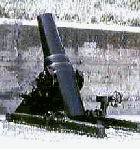
|
|
|
|
|
|
FORT DE SOTO HISTORY
For over 400 years, the Tampa Bay area of Florida has attracted a wide variety of visitors to its shores. Some of the first were the Tocobaga Indians, who enjoyed the bounty of the harvest from Tampa Bay and the Gulf of Mexico. The savory clams, oysters, conchs, whelks and fish taken from the pristine waters must have been delightful as well as plentiful. But eventually all good things must come to an end and unfortunately, their paradise was spoiled with the coming of the first white man.
|
|
|
|
|
|
|
|
|
|
|
|
|
|
|
|
On April 15, 1528, a Spanish explorer by the name of Panfilo de Navarez landed on the West coast of Florid . It is believed he came ashore somewhere between St. Petersburg Beach and Clearwater. He and his group of conquistadors explored the barrier islands of the area before moving up the coast.
On May 30, 1539, a well known Spanish explorer came to the Tampa Bay area and began a conquest which would change the world. Hernando De Soto came ashore on or near the South shore of Tampa Bay. He began his expedition of the Southeastern region of what is now the United States, encountering Indians and hard times as he passed through this beautiful territory. He died on May 21, 1542, and was buried in the Mississippi River to prevent his body from being taken by the Indians.
The recorded history of the islands known as Mullet Key began in February 1849 when a group of United States Army Engineers, aboard the schooner Phoenix, anchored offshore to survey the coastline for possible use as a coastal defense area. Among them was a young Brevet Colonel named Robert E. Lee. The four engineers were studying the islands at the mouth of Tampa Bay - Passage, Egmont, and Mullet Keys. In March 1849 the army engineers recommended Egmont and Mullet Keys for military utilization thereby prohibiting any private use or development.
The Civil War broke out in 1861, with no fortifications on either Mullet or Egmont Keys. The two islands played a minor role during the Civil War. Union troops set up a blockade using the two islands. Any Confederate attempting to run the blockade could be seen by the troops perched atop the Egmont Key lighthouse.
The first signs of construction on the Mullet Key military post began in November 1898. During the first six months, a 275 foot wharf extending into Tampa Bay was constructed, as well as an office, a mess hall, quarters for the workmen, and a stable. A narrow-gage railway ran between the wharf and a construction plant, with a spur line running to the future battery site. In March 1899 the crew was ready to begin pouring the foundation of the mortar battery. The land had been cleared and the foundation forms were set. There was one small problem. The stone, which was being transported by sailing ship, had not arrived from New York and New Jersey. In place of the stone, the workers used shell. The shell concrete formula worked so well in the foundation that it was decided, when the stone arrived on May 31, 1899, that they would simply add the stone to the shell, sand and cement mix to complete the construction of the walls and ceiling.
On April 4, 1990, the military reservation was named Fort De Soto after the Spanish explorer Hernando De Soto. Fort De Soto was officially a subpost of Fort Dade on Egmont Key at that time.
Captain Thomas H. Rees, engineer officer in charge of construction, announced the completion of the mortar battery on May 10, 1900, fourteen months after the first shovelfull of dirt was turned. He also could boast that the project stayed within its $155,000 budget. In fact, there was a balance of $16.73 remaining.
|
|
|
|
|
|
|
|
|
|
|
|
This battery was basically a new design for the military. Changes came about to improve coastal fortifications due to the recommendations from a committee led by Secretary of War, William C. Endicott. These modifications had to be initiated due to the significant changes in weapons. Previously, the forts of the United States had been exposed stone or brick, making the walls vulnerable to the direct fire of cannons. With the advent of rifled bores or barrels, weapons became more destructive. The new style fortifications had thick walls and ceilings and were camouflaged using massive amounts of dirt. To withstand the direct fire of a ship's weapons, the walls of this battery ranged from eight to twenty feet thick.
|
|
|
|
|
|
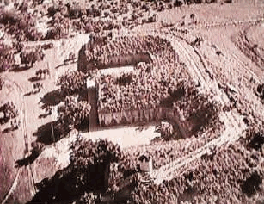
|
|
|
|
|
|
|
|
|
|
1920's-era aerial photograph showing basic design of the main battery area of the fort. The aiming point for the mortars, the entrance to Tampa Bay, is to the right.
|
|
|
|
|
|
|
|
|
|
|
|
|
|
|
|
|
The ceiling was five thick consisting of reinforced concrete with I-beams. There were approximately 72,000 cubic yards of sand covering the topside of the battery. Each of the two gun pits housed four 12-inch mortars. After the mortar battery was completed, funds were allocated to construct a battery for two 15-pounder rapid-fire guns. Work was completed on the gun battery in early 1902.
|
|
|
|
|
|
|
|
|
|
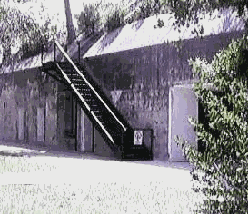
|
|
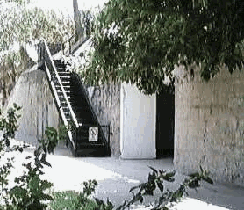
|
|
|
|
|
|
|
|
|
|
|
|
|
|
|
Landward side of the main battery area showing the thick concrete walls to support the sand overburden and provide blast protection for the troops and the powder and shot magazines. The thickness of the walls can be seen in the door leading to the magazine. The stairway gives access to the observation bunker.
|
|
|
|
|
|
|
|
|
|
|
|
|
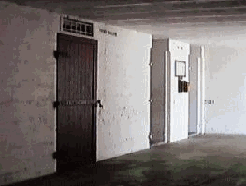
|
|
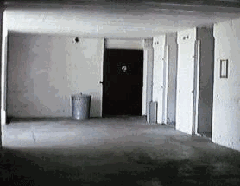
|
|
|
|
|
|
|
|
|
|
|
|
Interior views of the magazines. The doors lead to separate chambers for the storage of powder, shot and primers. The Florida State Park Service has done an excellent job of stabilizing and restoring the main battery area. The fort is under constant attack by the marine environment.
|
|
|
|
|
|
|
|
|
|
|
|
|
|
|
|
Both batteries were without weapons for some time. The eight 12-inch M1890-M1 mortars were not mounted until the summer of 1902, and the two 15-pounder or 3-inch Driggs-Seabury rapid-fire guns were finally in place in 1903. When first installed, the 12-inch mortars were not functional because they did not have the new style electrical firing devices. An order went out for mechanics to be summoned to the fort to install and assemble the devices to the breech blocks. The work was completed and the mortars, as well as the two 15-pounder rapid fire guns, were test fired November 19 and 20, 1903. The 12-inch mortar battery was named Battery Laidley in honor of Colonel Theodore T. Laidley who fought in the war with Mexico as well as the Civil War, and died in Palatka, Florida. The 3-inch gun battery became Battery Bigelow in honor of 1st Lt. Aaron Bigelow of the 21st U.S. Infantry, who was killed at the battle of Lundy's Lane, Ontario, during the War of 1812.
|
|
|
|
|
|
|
|
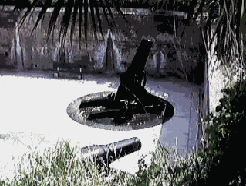
|
|
|
|
|
|
|
|
|
The eight 12-inch M1890-M1 mortars, manufactured in Watervliet Arsenal, Watervliet, New York, were breech-loading and rifled. The weapon had safety features built in, such as a device which kept the mortars from being fired until the breech locks were secured and the weapons were elevated to the minimum 45 degrees.
Each gun had a twelve man crew to manually load and aim it. The crew would choose from projectiles weighing 800, 824 or 1046 pounds, along with a powder charge in a silk bag weighing 54 to 67 pounds.
After the powder bag was in the mortar, the sergeant would hang a fuse containing 1 1/4 pounds of black powder onto the breech end of the powder bag. The fuse was ignited by the electrical primer which fired the silk bag powder charge. The minimum range of the mortar was 1.25 miles at 70 degrees and a maximum range of 6.8 miles at 45 degrees.
|
|
|
|
|
|
|
|
|
|
|
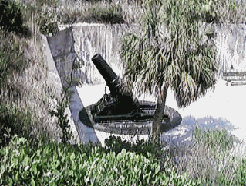
|
|
|
|
|
|
|
|
|
|
The two 3-inch rapid-fire guns were Driggs-Seabury Model 1898. he projectiles weighed 15 pounds and the nitrocellulose powder charge weighed 5 pounds. The maximum elevation was twelve degrees with a range of 4.5 miles at that setting.
|
|
|
|
|
|
|
|

|
|
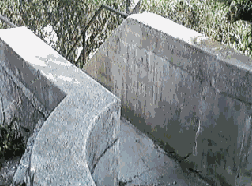
|
|
|
|
|
|
|
|
|
|
|
|
Data booth where direction and rang information was converted in to azimuth and elevation numbers for the mortar crews. The slate boards on the right side of the booth signaled the information to the gun crews.
|
|
|
|
|
|
|
|
|
|
|
|
|
|
|
Observation parapet on top of the fort's sand overburden. From this post, as well as other including the observation tower, observers would report direction and distance of targets as well as report the impact area of the projectiles.
|
|
|
|
|
|
|
|
|
|
|
|
|
|
|
|
To spot the enemy in the Gulf of Mexico, the post had observers on towers and at the top of Battery Laidley. They would see a ship coming over the horizon and relay the information to the relocating room in the mortar battery. The information would be telephoned to the data booths, where it would be translated and posted on slate boards for the gun crew to view. After the mortars were set in position, the gun commander would insert the electrical firing plug and the guns would be fired from the firing room. The Army would tow a barge behind a boat in the Gulf to fire at for practice.
Post buildings were constructed between early 1900 and 1906. There were 29 buildings including a 100-foot long barracks, a hospital, a stable, a guardhouse, a shop for blacksmiths and carpenters, an administration office, a mess hall and kitchen, a bakehouse, and a storehouse. All of the buildings were wood with slate roofs. The total cost of the post structures amounted to $120,674.55. This did not include the expense of the water and sewer systems. The water for the post was pumped from an artesian well (500 feet deep, with a capacity of 150 gallons per minute) into a 60,000-gallon tank, elevated 75 feet, and distributed through pipes to the various buildings. This water was only used for bathing, flushing toilets, and other such activities. Water for drinking was supplied by thirteen tanks or cisterns. Each tank had a capacity of 6,000 gallons. The system was installed in 1901 and cost $17,754. The post had a modern sewer system, which drained into the Gulf of Mexico and Tampa Bay through 6- and 8-inch pipes and was installed at a cost of $3,426.
Fort De Soto's designation changed several times through the years from subpost of Fort Dade to independent post. Fort Dade had approximately 250 troops stationed on Egmont Key compared to approximately 125 at Fort De Soto on Mullet Key. Fort Dade had much more to offer the soldiers such as tennis, baseball, bowling, a gymnasium, movie theater, and more. Records do not show these activities at Fort De Soto. However, both posts shared in the misery of having horrendous hordes of mosquitoes. The troops could not even enjoy the nice beaches on the island due to the vampire pests. The post quartermaster gave this report in 1908:
"The suffering of the men daily at work or drill has been greater than can be imagined by any who have not actually experienced it. There have been nights that the men have had no sleep due to mosquitoes in quarters, even though mosquito bars (nets) are used. At present, life for the men is a torture both night and day, and the mosquitoes have to be fought with a brush continuously whether at work or resting."
The chief Surgeon of the Department of the Gulf stated, "If this post is to continue as a station, life for those concerned should be, at least, made bearable." The Commander of the Department of the Gulf recommended that the sale of beer and light wines be permitted in the post exchange at Fort De Soto to add to the "contentment and discipline" of the garrison.
In 1900, Fort De Soto was garrisoned by a detachment of Company A, 1st Artillery. In 1901, artillery ranks were reorganized and the company became the 1st Company, Coast Artillery. In April 1907, the 1st Company shipped out and was replaced by the 39th Company, Coast Artillery, which stayed at Fort De Soto for three years until June 8, 1910. The number of troops had been cut with the act of February 2, 1901, which created the Coast Artillery. Supplemental troops would be provided by state forces in the event of an invasion.
There were three joint maneuvers at Fort De Soto with the U.S. Army and state troops. In 1907 and 1908, the 1st and 2nd Infantry, Florida State Troops, and in 1909 the 1st Company, Coast Artillery Corps, National Guard of Florida, participated in training exercises.
Eight months after the third maneuver, the Fort De Soto garrison was transferred to Fort Morgan, Alabama, and the fort became inactive with just a caretaker detachment remaining. By September 1914, there was one sergeant and a game warden from the Department of Agriculture remaining on the island. At that time Mullet Key was being used as a hunting preserve for Fort Dade.
During the first months of 1917, the Army had assigned one non-commissioned officer and eight privates to Fort De Soto. Another group of soldiers arrived to dismount and ship four of the 12-inch mortars to Fort Rosecrans in San Diego, California. Throughout most of World War I, the detachment had twenty-two privates, two non-commissioned officers and two officers.
On November 23, 1922, the Secretary of War wrote a letter to the Governor f Florida explaining that the Army would be closing Forts Dade and De Soto. The following are excerpts of that letter:
"Modern developments in armament required considerable modifications in our coastal defense plans and the defense of much of our coastline can better be accomplished by utilizing mobile artillery instead of fixed armament. The maintenance of Forts Dade and De Soto is not now essential to the coastal defense, and sufficient mobile artillery is available to protect Tampa. The limited personnel for Coast Artillery purposes, the question of future appropriations, and the damage wrought by the severe storm in October 1921 were also considerations."
On May 25, 1923, both forts were abandoned, leaving one caretaker at each post.
In 1926, the U.S. Congress authorized the Secretary of War to ell surplus military reservations, including Forts Dade and De Soto. The state, county and city governments chose not to purchase the property for the appraised price of $192,000. Therefore, the land was offered for public sale by sealed bid to be opened April 16, 1928. There were two bids and both were rejected.
Many storms had hit Fort De Soto during its short life including hurricanes in October 1921, September 18, 1926, and September 4, 1935. In October of 1932, there were still twenty-six of the original twenty-nine post buildings standing even after the storms. However, the average estimated value of each had fallen to $250, or a total of $6,000 compare to the original construction cost of over $120,000. Also that same month, Battery Bigelow collapsed and was swallowed by the Gulf of Mexico.
|
|
|
|
|
|
|
|
|
|
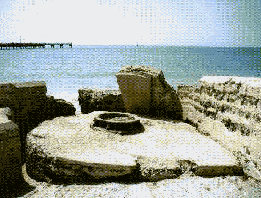
|
|
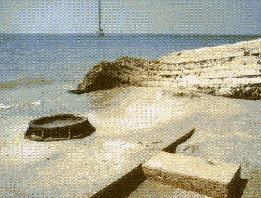
|
|
|
|
|
|

|
|
|
|
|
|
|
|
The second Driggs-Seabury mount. The majority of the fortification has been buried by sand. The undermining caused by huricanes has caused the fortification to sink in the sand. The gun mounts are locatd on the roof of the third story of the fortification.
|
|
|
|
|
|
|
|
|
|
|
|
|
|
|
|
The United States Army was not the only government agency to occupy Mullet Key. The Hillsborough County Board of Health maintained a quarantine station from December 16, 1889, until May 1889. The Secretary of the Treasury transferred 271 acres of the eastern end of Mullet Key to his department for quarantine purposes in May 1889. There were four buildings removed from Egmont Key and rebuilt on an area of Mullet Key adding to the existing cottage and sanitary facilities. In 1901, the Marine Hospital Service took over jurisdiction of the station from the Florida State Board of Health. In 1902, the agency's name was changed to Public Health and Marine Hospital Service. The duty of the station was to inspect aliens aboard ships from foreign ports. The station had fifteen buildings in 1925. The mosquitoes were a problem for this organization as well. In 1923, the Public Health Service was given permission to begin mosquito eradication on the portion of Mullet Key that the Army had occupied. Their program was a success.
The Mullet Key Quarantine Station was no longer needed when the Public Health Service moved their headquarters to Gadsen Point, outside of Tampa, in 1937. On September 29, 1938, the Pinellas County Board of County Commissioners bought the 271-acre tract on Mullet Key for $12,000.
The War Department made a decision in 1940 to turn Mullet Key into a bombing range. The Army negotiated with the Department of the Interior and Pinellas County, and the tract was returned to military status and became a subpost of MacDill Field in June 1941.
On August 11, 1848, after World War II was over, Mullet Key was sold back to Pinellas County for $26,495.24. That price included the original 271 acres, plus 613 acres which the military had occupied and was not included in the original price. Extensive plans were drawn up, and many dreams became a reality on May 11, 1963, when Fort De Soto Park was officially dedicated.
|
|
|
|
|
|
|
|
|
|
|
|
|
In 1977, the Fort De Soto batteries were placed on the National Registry of Historic Places. A visitor coming to Fort De Soto Park today can view the remains of Battery Laidley and the last four 12-inch M1890-M1 mortars remaining in North America (The only other remaining in the world are in the Philippines). The ruins of Battery Bigelow can be seen in the surf of the Gulf of Mexico southwest of Laidley. Visitors can also notice two weapons which appear out of place on the east side of Battery Laidley. These are two 6-inch rapid-fire rifles manufactured by the W. B. Armstrong Company of England. They came from Battery Burchsted on Egmont Key and were part of the armament of Fort Dade. The gulf shoreline of Egmont Key was eroding severely and the weapons were in danger of being lost. Through the joint efforts of the Army Reserve, the State of Florida, and the Pinellas County Highway and Parks Department, the weapons were saved, refurbished over a two year period, and mounted in 1980. This action has preserved another segment of the rich history of the area.
Fort De Soto was never the site of any major battle. In fact, the weapons of Fort De Soto and Fort Dade were never fired in anger at an enemy. However, that era was significant in terms of the evolution of modern weaponry.
Take a long walk along the southwest tip of the island where the post buildings were located, or climb to the top of the fort and look out over the area. Imagine this area at the turn of the century and the hardships the troops faced - mosquitoes, heat, isolation - and you will appreciate what we have in this modern age of mosquito repellent, air conditioning, automobiles, and fine roads. However, the troops of Fort De Soto never had those conveniences and were forced to brave some of the worst elements a person could suffer.
We salute these fine men and all the troops that have come before and after them. We thank them all for their dedication in obtaining and preserving the freedom this country has come to love and appreciate.
|
|
|
|
|
|
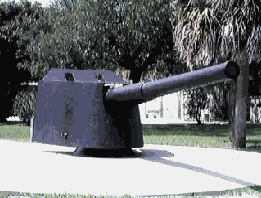
|
|
|
|
|
|
|
|
|
|
|
|
Armstrong 6-inch direct-fire weapon recued from Egmont Key. These weapons are fitted with splinter (shrapnel) shields to protect the gun crew.
|
|
|
|
|
|
|
|
|
|
|
|
|
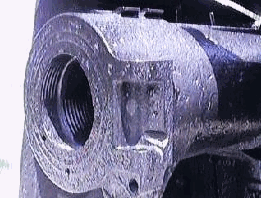
|
|
|
|
|
|
|
|
|
|
|
|
Breech-end of the Armstrong 6-inch rifle. The severe pitting testifies to the corrosive action of the salt and moisture of a marine environment.
|
|
|
|
|
|
|
|
|
|
|
|
|
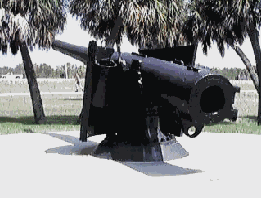
|
|
|
|
|
|
|
|
|
|
|
|
The second of two Armstrong 6-inch rifles stands as a mute sentry overlooking the old parade ground.
|
|
|
|
|
|
|
|
|
|
|
|
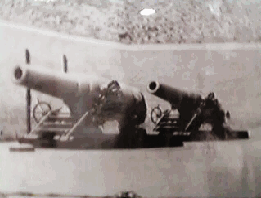
|
|
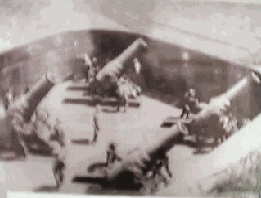
|
|
|
|
|
|
|
|
|
|
|
Period photographs (Spanish-American War era) of the M1890-M1 12-inch breech-loading mortars.
|
|
|
|
|
|
|
|
|
|
|
|
|
|
|
|
|
Text by Florida States Park Service.
Photos, except as noted, taken with Casio QV-10 Digital Camera - All rights reserved
|
|
|
|
|
|
|


















